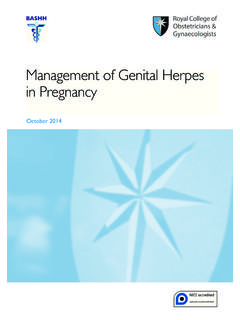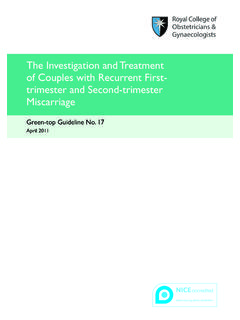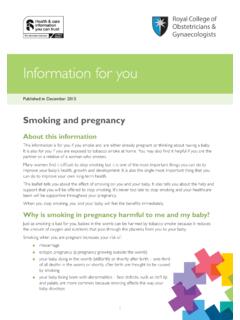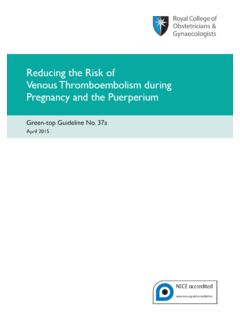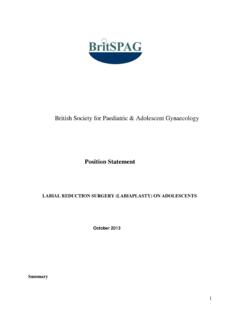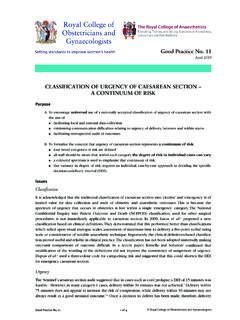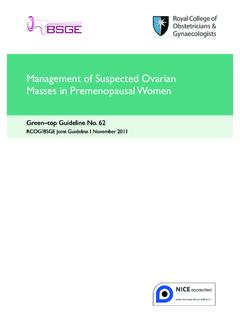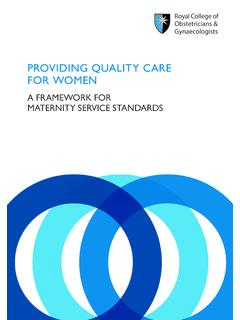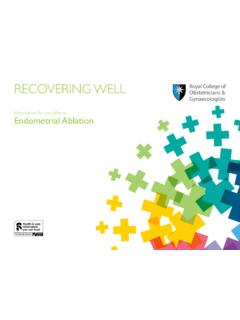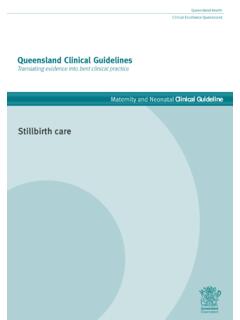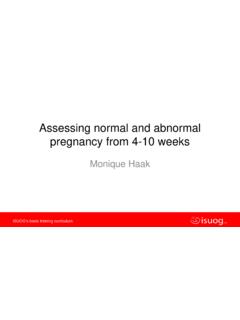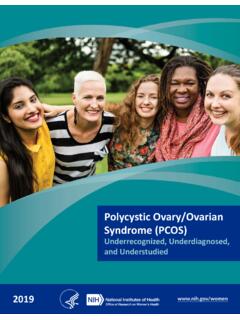Transcription of Surgical Management of Miscarriage
1 Surgical Management of Miscarriage and Removal of Persistent Placental or Fetal RemainsConsent Advice No. 10 (Joint with AEPU)January 2018 Surgical Management of Miscarriage and Removal of PersistentPlacental or Fetal RemainsThis is the second edition of this guidance, which was published in 2010 under the title Surgical Evacuation ofthe Uterus for Early pregnancy Loss. This paper provides advice for health professionals obtaining consent from women undergoing surgicalmanagement of Miscarriage with electric or manual vacuum aspiration. It is also intended to be appropriatewhen Surgical intervention is indicated for an incomplete termination of pregnancy , incomplete or delayedmiscarriage, or partially retained placenta after delivery. After careful discussion with the woman, the consentform should be edited under the heading Name of proposed procedure or course of treatment to accuratelydescribe the exact procedure to be performed.
2 The paper follows the structure of Consent Form 1 from theDepartment of Health, England1/Welsh Assembly Government2/Department of Health, Social Services and PublicSafety, Northern should be used as part of the consent process outlined in the Royal College ofObstetricians and Gynaecologists (RCOG) website at , and in conjunction with the RCOGC linical Governance Advice No. 6 Obtaining Valid Consent4and Clinical Governance Advice No. 7 PresentingInformation on also refer to the National Institute for Health and Care Excellence (NICE) clinicalguideline 154 Ectopic pregnancy and Miscarriage : diagnosis and initial aim of this advice is to ensure that all women are given consistent and adequate information for is intended for use together with dedicated patient information. At discharge, women should be provided withclear direction to enable them to obtain help if there are unforeseen problems after professionals obtaining consent should be prepared to discuss with the women any of the points listedon the following pages.
3 Risks may be quantified using the descriptors information on riskTermEquivalent numerical ratioColloquial equivalentVery common1/1 to 1/10A person in familyCommon1/10 to 1/100A person in streetUncommon 1/100 to 1/1000A person in villageRare1/1000 to 1/10 000A person in small townVery rareLess than 1/10 000A person in large townThe descriptors are based on the RCOG Clinical Governance Advice No. 7 Presenting Information on Risk,5and are used throughout usedSome of the terms used in this consent document may be upsetting for women, and it is important to assesstheir reaction to the language used to ensure that the most acceptable words are used for the individual bearingin mind that this may be a very difficult time emotionally. pregnancy tissue and pregnancy remains are allappropriate words to use, although each of these terms may be acceptable or not, for some Advice No.
4 102 of 10 Royal College of Obstetricians and GynaecologistsCONSENT of proposed procedure or course of treatmentSurgical removal of retained pregnancy tissue under general or local Proposed procedureDescribe the nature of the procedure taking into account the emotional impact of losing a baby: removal ofpersistent placental or fetal tissue from the uterus, usually using suction. Explain the procedure as described inthe RCOG patient information leaflets Early miscarriage7and Recovering from Surgical Management of a Miscarriage ,8or locally produced information materials. Where clinically appropriate, offer women undergoing early pregnancyloss ( Miscarriage ) a choice of manual vacuum aspiration under local anaesthetic in an outpatient or clinic setting,or Surgical Management in an operating theatre under general anaesthetic.
5 If an intrauterine pregnancy has not been confirmed on transvaginal ultrasound scanning prior to surgery andother procedures are anticipated, such as diagnostic laparoscopy to exclude ectopic pregnancy , these must bediscussed and separate consent obtained. If the woman wishes to avoid a pregnancy after the procedure, sensitively counsel the woman regarding contra-ceptive options. Surgical Management of Miscarriage can be an opportunity for the insertion of intrauterinecontraception to avoid the woman having the insertion at a later date. Additional consent should be obtainedif the woman wishes to have intrauterine contraception inserted at the time of the Surgical Intended benefitsThe aim of the procedure is to treat an incomplete or delayed Miscarriage , an incomplete termination ofpregnancy or Surgical Management of Miscarriage , or partially retained placenta after delivery.
6 NICE recommendexpectant Management for 7 14 days as first-line treatment to be offered to women with a confirmed diagnosisof or medical Management can be offered when expectant treatment is not acceptable tothe woman or has failed. Surgical Management should be first-line treatment if there is a medical indication forsurgery, such as sepsis, heavy bleeding or haemodynamic instability, or there is a suspicion of gestationaltrophoblastic disease. The Miscarriage Association and the Association of Early pregnancy Units supportdiscussing with women all options that are clinically appropriate and locally and frequently occurring risksThe overall (significant) complication rate for Surgical evacuation of the uterus is approximately 6%.6,9,10It isimportant for health professionals to differentiate between serious and frequently occurring risks whendiscussing the procedure with the patient, and these are the two categories presented on the consent form inorder to facilitate this who are obese, who have significant pre-existing medical conditions or who have had previous surgerymust be made aware that the quoted risks for serious or frequent complications may be risks (very common or common)Bleeding Bleeding that lasts up to 2 weeks is common.
7 Heavy bleeding necessitating blood transfusion is uncommon;estimated range from 0 to 3 in 1000 cases (uncommon).11,12 Royal College of Obstetricians and Gynaecologists3 of 10 Consent Advice No. 10 Bleeding at the time of the procedure or shortly after can be caused by uterine atony, coagulopathy or abnormalplacentation, and by complications such as uterine perforation, cervical laceration and retained pregnancy heavy bleeding at the time of surgery in a woman with a history of previous caesarean sectionshould alert the surgeon to the possibility of a previously undiagnosed caesarean scar pregnancy . Many earlycases of gestational trophoblastic disease are not detected by transvaginal ultrasound scanning. If there isunexpected heavy bleeding at the time of the procedure the surgeon should consider this.
8 Persistent (for more than 14 days post surgery) or very heavy bleeding should be investigated for a possibleincomplete procedure or retained placental and/or fetal Randomised controlled trials (RCTs)9,13have reported localised pelvic infection in up to 40 in 1000 women(common).Retained placental or fetal tissueThe incidence of retained placental or fetal tissue is up to 40 in 1000 women (common).9,13,14 Studies have shown that the incidence of repeat surgery following Surgical evacuation ranged from 3 in 1000(uncommon) to 18 in 1000 (common).14,15An RCT16found that transvaginal ultrasonography carried out in theatre once surgery was thought to becomplete reduced the incidence of an incomplete procedure. Limitations on the generalisability of this studyinclude the requirement for an appropriately maintained, high-resolution ultrasound scanner, ideally with atransvaginal probe, and the technical expertise to perform and interpret the adhesions A systematic review17of intrauterine adhesions after Miscarriage included ten studies and reported an incidenceranging from 3 38%.
9 This gave an overall pooled incidence following any type of Management (spontaneous orexpectant, medical and Surgical evacuation of the uterus) for early pregnancy loss to be 19% (190 in 1000;common) of women. For Surgical evacuation, the risk was , in over one-half of these women, the severity and extent of these adhesions were mild (mild, ;moderate, ; and severe, ) and the adhesions were of unknown clinical significance. No significantdifferences were shown in long-term fertility outcomes with medical, Surgical or expectant Management althoughthe numbers of studies and of included women were reviews17,18have shown that the frequency and severity of intrauterine adhesions are proportional to thenumber of evacuation procedures Serious risksPerforation A multicentre observational study19estimated the rate of confirmed uterine perforation to be 1 in 1000(uncommon).
10 Consent Advice No. 104 of 10 Royal College of Obstetricians and GynaecologistsHowever, an observational study16showed that a number of perforations may not be diagnosed and theincidence may be significantly higher: up to 15 in 1000 women (uncommon).Most perforations are small, not clinically significant and effectively managed conservatively. Cervical priming is used with the aim to reduce the possibility of injury to the uterus and cervix, and to improvethe Surgical ease of the procedure. However, a Cochrane review20concluded that although the use of cervicalprimers reduced the need for mechanical dilation and reduced the operating time, none of the included studiesreported data on the review's primary outcome: cervical or uterine use of cervical primers wasassociated with increased abdominal pain.
